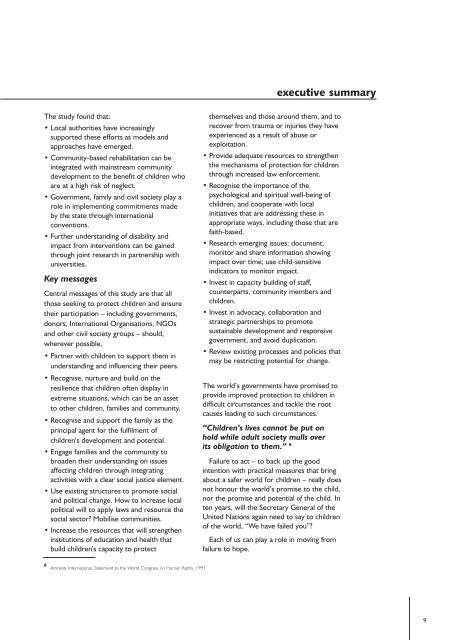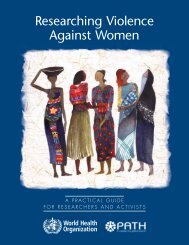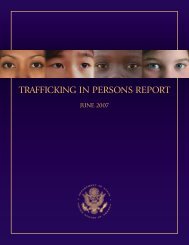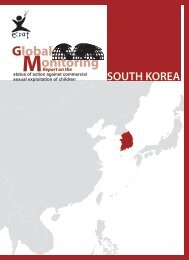Download PDF - Violence Against Children - East Asia and the ...
Download PDF - Violence Against Children - East Asia and the ...
Download PDF - Violence Against Children - East Asia and the ...
You also want an ePaper? Increase the reach of your titles
YUMPU automatically turns print PDFs into web optimized ePapers that Google loves.
executive summary<br />
The study found that:<br />
<strong>the</strong>mselves <strong>and</strong> those around <strong>the</strong>m, <strong>and</strong> to<br />
• Local authorities have increasingly<br />
recover from trauma or injuries <strong>the</strong>y have<br />
supported <strong>the</strong>se efforts as models <strong>and</strong><br />
experienced as a result of abuse or<br />
approaches have emerged.<br />
exploitation.<br />
• Community-based rehabilitation can be • Provide adequate resources to streng<strong>the</strong>n<br />
integrated with mainstream community <strong>the</strong> mechanisms of protection for children<br />
development to <strong>the</strong> benefit of children who through increased law enforcement.<br />
are at a high risk of neglect.<br />
• Recognise <strong>the</strong> importance of <strong>the</strong><br />
• Government, family <strong>and</strong> civil society play a psychological <strong>and</strong> spiritual well-being of<br />
role in implementing commitments made children, <strong>and</strong> cooperate with local<br />
by <strong>the</strong> state through international<br />
initiatives that are addressing <strong>the</strong>se in<br />
conventions.<br />
appropriate ways, including those that are<br />
faith-based.<br />
• Fur<strong>the</strong>r underst<strong>and</strong>ing of disability <strong>and</strong><br />
impact from interventions can be gained • Research emerging issues; document,<br />
through joint research in partnership with monitor <strong>and</strong> share information showing<br />
universities.<br />
impact over time; use child-sensitive<br />
indicators to monitor impact.<br />
Key messages<br />
• Invest in capacity building of staff,<br />
Central messages of this study are that all counterparts, community members <strong>and</strong><br />
those seeking to protect children <strong>and</strong> ensure children.<br />
<strong>the</strong>ir participation – including governments, • Invest in advocacy, collaboration <strong>and</strong><br />
donors, International Organisations, NGOs strategic partnerships to promote<br />
<strong>and</strong> o<strong>the</strong>r civil society groups – should,<br />
sustainable development <strong>and</strong> responsive<br />
wherever possible,<br />
government, <strong>and</strong> avoid duplication.<br />
• Review existing processes <strong>and</strong> policies that<br />
• Partner with children to support <strong>the</strong>m in<br />
may be restricting potential for change.<br />
underst<strong>and</strong>ing <strong>and</strong> influencing <strong>the</strong>ir peers.<br />
• Recognise, nurture <strong>and</strong> build on <strong>the</strong><br />
resilience that children often display in The world’s governments have promised to<br />
extreme situations, which can be an asset<br />
provide improved protection to children in<br />
difficult circumstances <strong>and</strong> tackle <strong>the</strong> root<br />
to o<strong>the</strong>r children, families <strong>and</strong> community.<br />
causes leading to such circumstances.<br />
• Recognise <strong>and</strong> support <strong>the</strong> family as <strong>the</strong><br />
principal agent for <strong>the</strong> fulfilment of<br />
“<strong>Children</strong>’s lives cannot be put on<br />
children’s development <strong>and</strong> potential. hold while adult society mulls over<br />
its obligation to <strong>the</strong>m.” 6<br />
• Engage families <strong>and</strong> <strong>the</strong> community to<br />
broaden <strong>the</strong>ir underst<strong>and</strong>ing on issues<br />
Failure to act – to back up <strong>the</strong> good<br />
affecting children through integrating<br />
intention with practical measures that bring<br />
activities with a clear social justice element. about a safer world for children – really does<br />
• Use existing structures to promote social not honour <strong>the</strong> world’s promise to <strong>the</strong> child,<br />
<strong>and</strong> political change. How to increase local nor <strong>the</strong> promise <strong>and</strong> potential of <strong>the</strong> child. In<br />
political will to apply laws <strong>and</strong> resource <strong>the</strong> ten years, will <strong>the</strong> Secretary General of <strong>the</strong><br />
social sector? Mobilise communities.<br />
United Nations again need to say to children<br />
of <strong>the</strong> world, “We have failed you”?<br />
• Increase <strong>the</strong> resources that will streng<strong>the</strong>n<br />
institutions of education <strong>and</strong> health that Each of us can play a role in moving from<br />
build children’s capacity to protect<br />
failure to hope.<br />
6 Amnesty International, Statement to <strong>the</strong> World Congress on Human Rights, 1993<br />
9

















